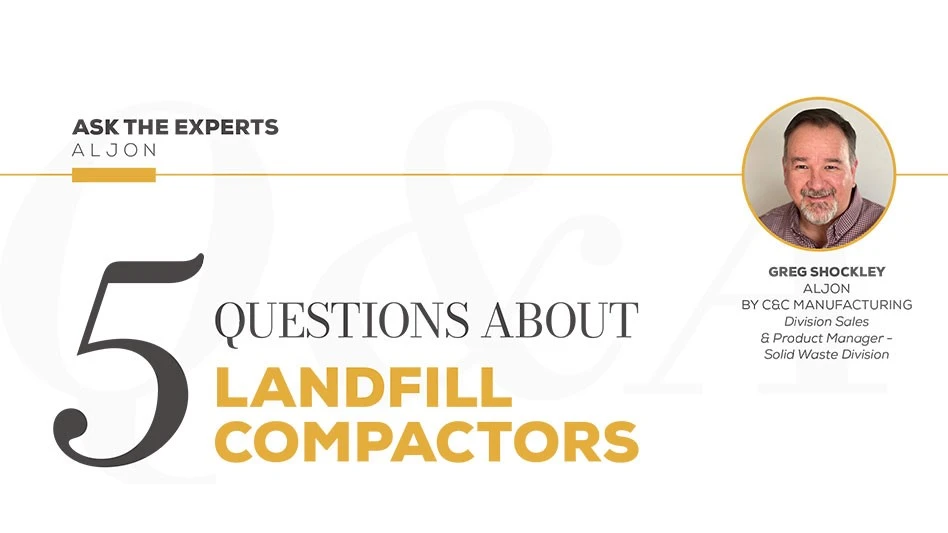

1. How important is the landfill compactor in the operation of a landfill?

Aljon by C&C Manufacturing
Division Sales & Product Manager - Solid Waste Division
Although a landfill requires a large variety of equipment to operate efficiently, most would agree the landfill compactor is the most important. The cost associated with constructing a new cell in a landfill can range from $300,000 to $500,000 per acre. Optimal compaction ratios produced by the compactor are one of several factors to preserve landfill air space, maximizing the material processed into the cell as well as the revenue.
2. Which primary factors should be considered when choosing a compactor?
We like to talk about maintenance and uptime first and foremost. Regardless of which brand or design of machine used, if the machine has excessive downtime, it is not performing to the customer’s expectations.
Secondly, we challenge our customers to consider the PLI (pounds per linear inch) rating of the compactor. The machine’s ability to compact material can be calculated in several ways, but PLI is the most practical and reliable way. PLI is calculated simply by dividing the weight of the machine by the surface area in contact with the material (wheel width). If we use our Aljon ADV600 as an example, it weighs 127,500 pounds and has four 52-inch wheels for a total of 208 inches of surface area in contact with the material. This simple calculation results in 613 pounds per linear inch of compaction.
3. How important are the machine’s wheel cleats for compaction?
Very important. The primary function of the cleats is to manipulate and crush the material, making it more compactable. While the PLI rating is most important, too many or not enough cleats can reduce compaction. The geometry of the cleat, cleat placement, quantity and the material from which the cleats are made all are important factors for compaction, cost of ownership, elimination of risk for wire wrap and more.
At Aljon, we configure the wheels specifically for each application, and we use MacPactor cleats, which, by design, contribute to our self-cleaning wheel, backed with a 10,000- to-15,000-hour wear-life guarantee, without the need for wire cutters or cleaner bars. They’re manufactured with a high content of abrasion-resistant material and range from 8 inches to 10 inches in height.
4. Does the volume of waste in a landfill determine the size of machine needed?
Regardless of the size of the machine, if operated properly using best practices and methodology, compaction ratios can be achieved. However, depending on the production demand, the machine’s ability to produce acceptable compaction ratios while keeping up with the flow of material is what determines the size of machine needed. This is calculated by dividing the weight of the machine by 100. That number equates to the average daily tonnage that the machine can process efficiently, i.e., 127,500 pounds/100 = 1,275 tons per day.
5. What is the best way to get more information regarding Aljon landfill compactors?
Aljon is American-made. Call your local sales representative to schedule a factory visit, email us at greg.shockley@candcmfg.net or visit our website at www.aljon.com. Be sure to visit us at SOAR, WasteExpo and WasteCon 2023.

Explore the November December 2022 Issue
Check out more from this issue and find your next story to read.
Latest from Waste Today
- EC Waste acquires fellow Puerto Rican hauling firm
- Goldman Sachs Alternatives to acquire Liquid Environmental Solutions
- Block Island Recycling Management Inc. aims to promote environmental stewardship
- Miami region officials seek WTE plant location
- Clean Harbors faces potential penalty for Ohio fatality
- New Hampshire governor signs leachate management bill
- MSS relocates to new facility in Nashville, Tennessee
- Houston weighs adding a solid waste fee





